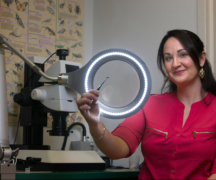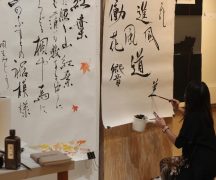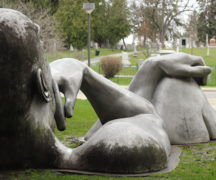By DAVID DUPONT
BG Independent News
Paul Morris knows that Kids’ Tech University presented at Bowling Green State University has a lot going for it.
Each of the four weeks features an esteemed scientist who knows how to talk to children age 9 to 12 about their research.
And then the kids have carefully designed activities related to the science that allow students to do the work of science themselves.
Then there’s Morris’ hair. He sports a frizzy mop of white hair. Morris said he’s gotten enough comments on it, he’s decided to stop cutting his hair. “I look the part.”
It’s a silly way to get across a key element of the program. “The idea that children are being directed by a real scientist that’s part of the excitement we want to capture.”
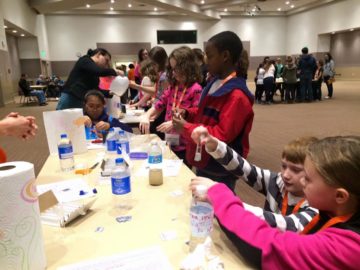 Registration is now underway for the program that runs four Saturdays throughout the semester starting Feb. 11 and continuing Feb. 25, March 18, and April 8. Each starts at 10 a.m. and continues until 3 p.m. or so. Registration is $90. Visit http://kidstechuniversity-bgsu.vbi.vt.edu/.
Registration is now underway for the program that runs four Saturdays throughout the semester starting Feb. 11 and continuing Feb. 25, March 18, and April 8. Each starts at 10 a.m. and continues until 3 p.m. or so. Registration is $90. Visit http://kidstechuniversity-bgsu.vbi.vt.edu/.
The mission is to get children excited about science, technology, engineering and math before they get into middle school.
The Feb. 11 session will feature Dr. Jennifer M. DeBruyn, who works at the Body Farm in Tennessee, a lab which studies decomposition of human bodies. DeBruyn is a microbiologist who studies how all manner of matter decomposes. Her talk is: “Life after Death: Exploring the decomposer organisms that recycle corpses back to soil.”
In the afternoon, Morris said, students will do an array of experiments involved in forensics, including fingerprinting and DNA analysis with the assistance of BGSU faculty and students.
“The strategy is to enable them to meet and interact with scientists who talk about what they do, and as a second component we give them a variety of hands-on activities that we run that are related to speaker’s talk.”
Morris said he looks for activities “that I think the children would expect to do at a university.” That includes using lab equipment. “We do a lot of microscope work.”
As far as the speakers are concerned, he has an easy measure of their effectiveness: “To what extent is the speaker interrupted with questions, and how long does the speaker section extend with questions? If no questions, it’s a failure.”
When his BGSU colleague Peg Yacobucci talked about dinosaurs and climate change, the kids asked questions for 40 minutes.
Only once, in the first year, has that been a problem. In the first year one speaker got too technical, he said.
“I’ve had talks that I thought were somewhat boring, but the kids loved it because it was a subject they really, really liked,” Morris said. “By and large I’ve been really pleased with the reaction the talks get. I’m glad I’m not doing it because I don’t know that I can live up to the standard.”
He said he gets plenty of satisfaction recruiting other scholars and working directly with the children during the hands-on portion of the sessions.
The other talks scheduled for the 2017 session are:
- “Life on Eight-Legs: Science and Discovery in the Enigmatic Archids” with Dr. Eileen Hebets, University of Nebraska, Feb. 25.
- “Roots – the hidden half of plants and how they are made” with Dr. Lucia Strader, Washington University in St. Louis.
- “How do microscopes help scientists understand what makes up a cell” by Dr. Andrea Kalinoski, University of Toledo.
“What I’m looking for in a speaker is someone who can talk science but also engage this audience,” Morris said.
Hebets, for example, is known nationally for her educational work, and last year presented at the USA Science and Engineering Festival in Washington, D.C.
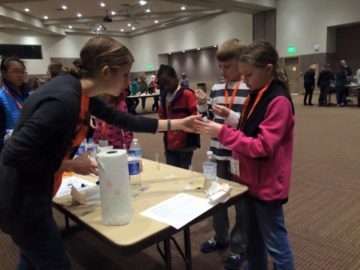 Usually Morris has someone from BGSU as a speaker, but this year scheduling precluded that.
Usually Morris has someone from BGSU as a speaker, but this year scheduling precluded that.
This will be Kids’ Tech sixth year. It started Morris said as part of a large grant funded by the US Department of Agriculture. The grant required an educational component.
Morris said he adopted the program, which had been developed at Virginia Tech.
The program continued beyond the first two years of grant funding, and now relies on registration fees for funding.
Because its roots as a USDA funded program, he always includes a session on plants. He also knows the importance of programs with local connections, so several have addressed topics related to Lake Erie.
Morris said there’s room for 100 students. Last year 70 enrolled, and he’d like to increase those numbers.
Students come from as far as Lima, with about half coming from Bowling Green.
One sign of success, he said, is that the program gets about 75 percent of students returning.
Some students who age out, come back as volunteers because there’s not another program for them to move into and they just can’t enough of science. “They like the program,” Morris said. “They like hearing the talks, and they like asking the questions.”


